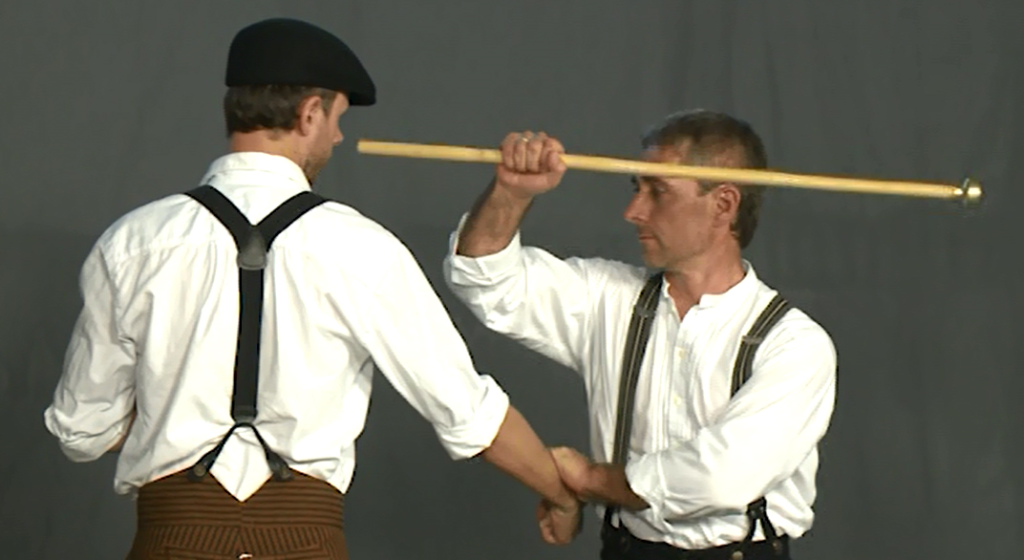- Originally published on the Bartitsu.org site on Thursday, 14th February 2019

I noticed that the stick itself was held about eight inches from the end, so that after a crashing blow has been delivered it was quickly followed up by a stabbing movement with the ferrule end, which was used as if it was a dagger.
- Street Self-Defence: How to Handle the Hooligan (1904)
One of the characteristic tactics of the Vigny stick fighting style is the use of the “short end” of the cane as a close-combat weapon. Despite not being directly illustrated in the classic Pearson’s Magazine series, this method is frequently referred to in other sources, notably including Captain F.C. Laing’s The ‘Bartitsu’ Method of Self-Defence:

Points are made with the butt end of the stick at any part of the body, the most favourable places being at the throat and ribs.
“Point” in Laing’s usage refers to a thrust as distinct from a strike, and either the butt or ferrule end or the heavier ball-handle end (as demonstrated by Vigny in the photograph above) could be used for this purpose.
Aside from the “backhanded” preparation described and illustrated by Laing, the Vigny style also includes a guard that prepares for a forehand or direct short-end strike, shown in the second of these four illustrations from a 1904 Detroit Free Press article:

The caption for this guard reads:
2) In this posture a blow is delivered from the shoulder, or as an alternative the small end of the weapon may be used as a dagger.
Numerous observers of Vigny’s stick fighting demonstrations at the turn of the 20th century noted his use of the short-end of the stick at close quarters, and especially its effectiveness as a surprise attack. An opponent who is set up to expect a sweeping strike with the cane may well be taken off-guard when his adversary steps in close and converts the “strike” into a stabbing thrust with the opposite end. This description, from the London Daily News of Wednesday, October 29, 1902, is typical:
Holding a malacca cane by one hand at each end, the Professor calmly awaited the onslaught of a skilled opponent with a similar stick. The spectator never knew which hand was to deal the blow, the released end moving with lightning speed, and a short hold was taken, so that the assailant, in guarding against an impending blow, often found himself hammered or prodded with the butt.
Favoured targets for the short-end strike include the ribs, face, throat and eyes. According to the anonymous author of L’Art de la Canne (1912), a detailed survey of the Vigny style:
After which, you advance upon him while quickly turning your wrist, thrusting the steel ferrule of the cane like a dagger into his eyes or beneath his nose. And here is a man … amazed!
… whereas Captain Laing favoured the throat:
Assume “first position,” guard head, then, before he has time to recover himself, hit him rapidly on both sides of his face, disengaging between each blow as explained, the rapidity of these blows will generally be sufficient to disconcert him; the moment you see this; dash in and hit him in the throat with the butt end of your stick, jump back at once and as you jump hit him again over the head.
A man without a stick rushes at you with his fist. He will probably strike out at your face or body with his left hand; if so, take up the ” rear guard” position and as he strikes guard with left arm, seize his left wrist, and hit his left elbow with your stick, advance right leg and point with butt end of your stick at his throat, then follow this up by thrusting your stick between his legs and so levering him over.
Laing’s prototype for a new cavalry sword design, which was based on Bartitsu stick fighting, included a spiked pommel for even more effective close-quarters work:

Those interested in the further possibilities of short-end play with the Vigny cane are encouraged to study the video series Bartitsu: Historical Self-Defence with a Walking Stick, which includes several more options.

